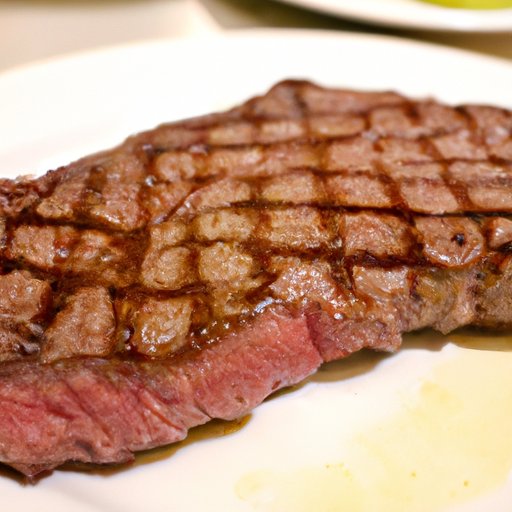I. Introduction
Steak is undoubtedly a delicious and satisfying meal, but its high calorie content often deters health-conscious individuals from indulging. However, there’s plenty of good news to uncover when it comes to the nutritional content of steak. In this article, we will be exploring the calorie counts of different cuts and types of steak, providing healthy and low-calorie recipe ideas, and comparing steak to other protein sources. Our aim is to help you make informed and healthy choices while still enjoying your favorite meals.
II. The Nutritional Benefits of Steak: A Comprehensive Look at Its Calorie Content
Steak is an excellent source of protein and essential vitamins and minerals, including iron, zinc, and vitamin B12. However, the calorie content of steak varies depending on the cut and type. A 3-ounce serving of ribeye, for example, contains around 240 calories, while a 3-ounce serving of sirloin steak contains about 150 calories. Choosing leaner cuts of steak, such as filet or flank steak, can significantly reduce the calorie count while still providing the same nutritional benefits.
Portion control is also essential when it comes to enjoying steak. A 4-ounce serving is considered a standard portion size, and a 6-ounce serving is still acceptable. However, anything more than that can quickly escalate the calorie count. To keep your serving size in check, consider using a food scale or practicing mindful eating techniques.
When comparing steak to other protein sources, the calorie count is relatively similar. A 3-ounce serving of chicken breast contains around 140 calories, while a 3-ounce serving of salmon contains 175 calories. However, steak tends to be more satiating and can keep you feeling fuller for longer periods, making it a great option if you’re trying to reduce overall calorie intake.
III. Healthy Steak Recipes Under 500 Calories
If you’re looking to cut back on calories without sacrificing taste, there are plenty of healthy steak recipe options to explore. Opting for lighter-ingredient dishes can significantly reduce the calorie count while still providing a delicious meal. For example, a lean steak salad with plenty of greens and a homemade vinaigrette is a filling and nutritious option, with most recipes clocking in at under 400 calories per serving. Similarly, steak fajitas made with lean slices of meat and plenty of vegetables are both flavorful and low in calories.
When preparing steak, it’s essential to avoid adding excess fat and calories. Breading or deep-frying are high-calorie cooking methods and should be avoided entirely. Instead, try grilling, baking, or pan-searing your steak with minimal oil. Not only does this method reduce the calorie content, but it also preserves the natural flavor of the meat.
IV. Steak vs. Other Proteins: How Does It Measure Up In Terms of Calories?
While the calorie count of steak is comparable to that of other protein sources, there are pros and cons to consider. For one, steak is an excellent source of iron, which is often lacking in other meats. Additionally, the high-fat content of steak can help you feel fuller faster, reducing overall calorie intake. However, excessive consumption of red meat has been linked to an increased risk of heart disease and some cancers. It’s essential to incorporate a variety of protein sources into your diet and use steak as a treat rather than a staple.
The chart below compares the calorie content of different protein sources:
| Protein Source | Calories per 3-ounce serving |
|---|---|
| Beef (ribeye) | 240 |
| Beef (sirloin) | 150 |
| Chicken breast | 140 |
| Salmon | 175 |
| Tofu | 70 |
V. The Calorie Argument for Grass-Fed Beef: Why It May Be a Smarter Choice
Grass-fed beef has become increasingly popular in recent years due to its perceived nutritional benefits. Compared to conventionally raised beef, grass-fed beef is lower in fat, calories, and cholesterol and higher in essential vitamins and minerals. Additionally, grass-fed beef is considered a more ethical and environmentally sustainable choice. Despite its higher cost, many individuals choose to eat grass-fed beef regularly due to its superior nutritional content.
VI. What to Eat With Your Steak to Keep the Calorie Count Low
While steak often takes center stage in a meal, it’s essential to include nutritious side dishes and accompaniments to create a balanced and satisfying meal. Some low-calorie side dish options include roasted vegetables, steamed greens, or a refreshing salad. If you’re looking to add some flavor without adding calories, consider whipping up a flavorful herb butter to melt over your steak or serving it with a zesty salsa or chimichurri sauce.
Pairing a variety of foods together can help keep meals interesting and healthy. Experiment with different flavor combinations and cuisines to keep your meals exciting and satisfying.
VII. Conclusion
Steak may have a reputation as a high-calorie indulgence, but with the right knowledge and approach, it can be a nutritious and satisfying addition to a healthy diet. Opting for leaner cuts and practicing portion control can help keep calorie counts in check, while exploring healthy recipe options can provide endless mealtime inspiration. By incorporating variety and balance, steak can be part of a healthy and enjoyable lifestyle.
